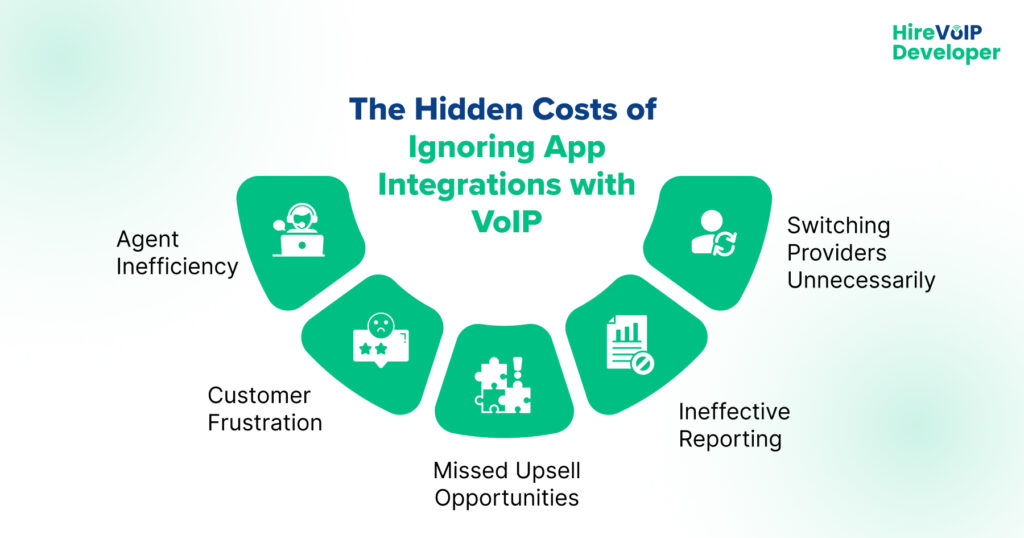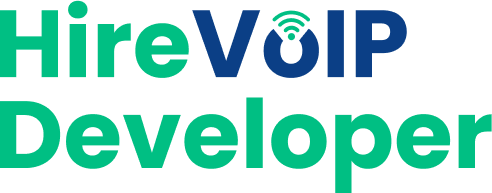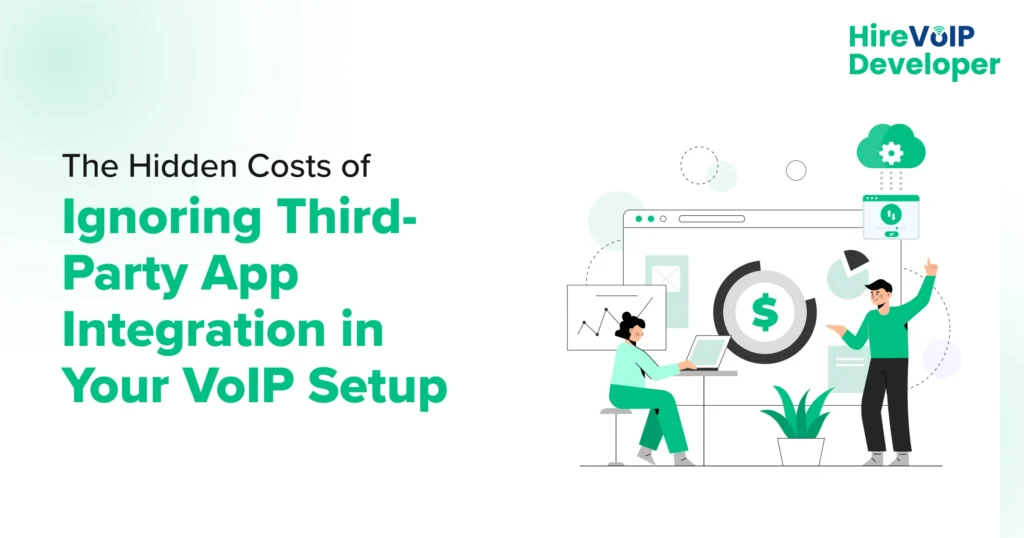📝 Blog Summary
The real cost of VoIP integration isn’t in the initial setup, but in what happens when you ignore it. Poor integration creates hidden operational costs, frustrated employees, and missed revenue opportunities that compound monthly. This blog reveals how business VoIP solutions succeed or fail based on integration strategy, not just call quality.
Most companies adopt VoIP because of its promise: lower costs, scalable infrastructure, and flexible communication across devices. But too often, they stop there.
Here’s the problem: a standalone VoIP setup works in isolation.
Your CRM doesn’t talk to your call system. Your helpdesk doesn’t know the last conversation your team had with a customer. Billing issues don’t automatically flag in the support queue. And agents waste time toggling between windows to piece together what should have been unified from the start.
Ignoring VoIP integration doesn’t just limit features. It silently erodes productivity and customer trust, creating hidden costs that grow over time.
The Hidden Costs of “VoIP Without Integration”
If your VoIP system isn’t connected to the apps your business runs on, you’re paying for it in less obvious ways:
Agent Inefficiency
A study found that agents dedicate 6%-12% of their work shifts to After-Call Work (ACW), which involves tasks such as logging calls, updating customer records, and completing administrative follow-ups.
Without CRM integration, agents manually log these call notes. That’s extra minutes per call multiplied by thousands of calls a month. Productivity loss adds up quickly.
Customer Frustration
Customers hate repeating themselves. Without unified data, every channel (sales, support, billing) acts in the dark. That frustration translates into churn.
Missed Upsell Opportunities
A sales agent can’t see product usage history during a call. A support rep doesn’t know that a renewal date is approaching. These blind spots cost revenue.
Ineffective Reporting
Without integration, VoIP only shows call volume and duration. What’s missing is the “why” behind those calls (trends hidden inside your CRM, ERP, or helpdesk).
Higher Long-Term Costs
Businesses often jump providers when VoIP feels “limited,” but the issue isn’t the core VoIP; it’s the missing integrations. Switching providers is far more expensive than extending your current setup.

Critical Third-Party Applications for VoIP Integration
Not all integrations are created equal. Smart businesses prioritize VoIP integration with applications that drive the most operational impact and customer value.
CRM Systems
CRM integration transforms every phone call from an isolated interaction into part of a complete customer journey.
Effective business VoIP solutions automatically:
- Pop customer records when calls arrive (screen pops)
- Log call duration, outcome, and notes automatically
- Trigger follow-up tasks based on call disposition
- Update opportunity stages based on call results
- Sync voicemails and call recordings to customer records
ERP Systems
ERP integration turns your VoIP system into a business intelligence tool.
When calls sync with ERP data, you unlock:
- Customer payment status visibility during support calls
- Inventory availability for sales conversations
- Order status updates without system switching
- Automatic case creation for billing disputes
- Service level agreement tracking and escalation
Helpdesk and Ticketing Systems
Support teams need instant context to resolve issues efficiently.
VoIP integration with helpdesk systems enables:
- Automatic ticket creation from voicemails
- Call history attached to support tickets
- Escalation workflows triggered by call patterns
- Customer satisfaction surveys are sent after call completion
- Knowledge base articles suggested during calls
Stop letting siloed apps drain your VoIP Investment
Analytics and Reporting with VoIP Integration
Isolated VoIP systems generate basic call statistics. Integrated scalable VoIP solutions produce business intelligence that drives strategic decisions and operational improvements.
Customer Journey Analytics
When VoIP data integrates with CRM and marketing systems, you can track complete customer journeys:
| Metric | Without Integration | With Integration |
|---|---|---|
| Call-to-Close Rate | Unknown | Tracked by campaign source |
| Customer Lifetime Value | Estimated | Calculated from all touchpoints |
| Support Cost per Customere | Basic | Includes call time, resolution rate |
| Sales Cycle Length | CRM-only data | Includes pre-sale call patterns |
Team Performance and Productivity Insights
Integrated systems reveal productivity patterns that basic call logs miss:
- Time-to-resolution correlation: Which support agents resolve issues fastest when they have customer context?
- Cross-selling effectiveness: Which sales reps best leverage call history for upselling?
- Customer satisfaction drivers: How does call preparation time impact customer ratings?
- Resource allocation optimization: When do teams need additional support based on call volume and complexity patterns?
Revenue Attribution and ROI Analysis
Business VoIP solutions with proper integration enable sophisticated revenue attribution:
- Track which marketing campaigns generate high-value phone leads
- Measure the revenue impact of improved call handling times
- Calculate the ROI of integration investments through productivity gains
- Identify seasonal patterns that inform staffing and resource planning
Real-Time Dashboards for Operational Excellence
Integration unlocks real-time visibility that enables proactive management:
- Live call queues with customer priority scoring
- Agent performance dashboards with context-switching metrics
- Customer satisfaction trends correlated with integration usage
- System health monitoring that includes both VoIP and connected applications
A Strategic VoIP Integration Roadmap
Smart businesses approach VoIP integration as a phased strategy rather than a one-time project. This approach maximizes ROI while minimizing operational disruption.
1. Audit Current Systems and Workflows
Start by mapping your critical tools (CRM, ERP, helpdesk, billing solution, collaboration, customer engagement platforms) and document how information flows between them today.
Where are agents copy-pasting data?
Where are conversations disconnected?
This “friction map” reveals your top integration priorities.
2. Define Integration Objectives
Not every app needs real-time VoIP integration.
Set clear goals:
- Reduce average call handling time
- Improve first-call resolution
- Unlock sales and upsell visibility
- Enable unified analytics and reporting
Prioritizing objectives avoids “integration for integration’s sake” and ensures ROI tracking from the start.
3. Phase Your Integrations
Rather than tackling everything at once, follow a phased approach:
- Phase 1: CRM + Helpdesk (biggest impact on customer experience)
- Phase 2: Analytics Dashboards (turn data into management insights)
- Phase 3: ERP + Advanced Systems (finance, operations, supply chain)
This staggered rollout minimizes disruption while proving value quickly.
4. Leverage APIs and Middleware
Choose VoIP platforms with open APIs and prebuilt connectors.
Middleware (iPaaS solutions) can bridge tools without heavy coding, future-proofing integrations as business systems evolve.
5. Enforce Governance and Training
Integrations succeed only if people use them. Standardize logging rules, set up call outcome templates, and provide hands-on agent training to ensure adoption. Establish governance for data synchronization so teams trust the information surfaced during calls.
6. Continuously Optimize
Monitor KPIs like call-to-close rates, resolution times, customer CSAT scores, and revenue attribution after each phase. Use insights to refine workflows, sunset unused integrations, and invest in additional ones that demonstrate measurable business value.
VoIP without integration does work technically, but you’re leaving most of the value on the table. The hidden costs aren’t always visible on invoices, but they show up in lost productivity, missed revenue, and declining customer loyalty.
🔗 Connect Your VoIP with the Tools That Power Your Business
What your business VoIP solution can do for you depends on how well your VoIP system connects with the rest of your business ecosystem. The companies that integrate smartly will reduce costs, unlock insights, and scale faster. Companies that don’t may continue to pay these hidden costs.
Every day you delay integration is another day your competitors gain ground through superior operational efficiency and customer experience.
Let’s build your integration strategy!


